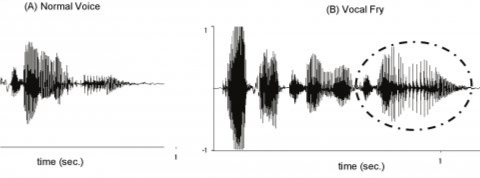
Vocular now does vocal fry, so I wanted to answer a few questions about that today – what is it, what does it mean, how can you tell how much you speak with, etc. Here we go.
What is vocal fry?
That’s that low-pitched, creaky, pulsating sound you hear most famously in the voices of women like Kim Kardashian and Zooey Deschanel.
How can you tell how much vocal fry you speak with?
Just like anything else, all you have to do is open the app, hit the record button and speak for about 30 seconds. The algorithm then analyses your voice to tell you how much vocal fry it finds. Anything over 15% is a lot, and anything under 6% is very little – although the app explains all this anyway. Check it out below.
Why is vocal fry important?
In theory, vocal fry should be a good thing. Deep voices are rated as being more authoritative. People are more easily persuaded by speakers who lower their pitch whilst making a point. Even CEO salaries rise as their pitch falls. So talking in vocal fry, the lowest register of the human voice, should be a good thing.
But studies tell us a very different story. Recent research looked at attitudes towards vocal fry using pairs of voices – both made by the same speaker – one with fry and the other without. The main finding: listeners were several times more likely to rate the fry voice as less trustworthy, less educated and less competent. They also claimed to be significantly more likely to hire the other voice.
How do you stop speaking with vocal fry?
You just do, really. Vocal fry is like any other bad habit, so unless you’ve got some rare vocal chord condition, you should be able to consciously keep your voice from falling into that lower register. Then it’s just a case of practising until it become second nature to you.
Why do people find vocal fry so annoying?
Well, there are some people who seem to want to put all this down to misogyny, like vocal fry is actually just a conduit for criticising women’s freedom of speech. Even a recent episode of Things You Should Know went down this route.
A lot of people are trying to dance around this or prove that it’s sexist – it’s like no, on its face, this is a sexist argument that’s going on right now.
This might be true for a few weirdos who write in to these shows, but it ignores basic differences in the way men and women speak. Female voices tend to be roughly twice as high as male voices, so it’s far more jarring when they keep dropping into registers down in Morgan Freeman territory. Some men, on the other hand, have voices deep enough that it’s really difficult to separate from their vocal fry. Even I have trouble doing this with myself.
Also, it’s not as though all female presenters are being chastised for their voices on the internet. Kirsty Young hosts Desert Island Discs, a show with an audience probably similar to something from NPR, and Twitter is awash with people announcing how much they love her voice. The difference? She has almost no vocal fry at all in her voice. She actually has the least of any woman in our database.
The anti-fry reaction isn’t limited to female voices either. The study I mentioned before found that vocal fry was equally disapproved of in male voices as it was in female ones.
There are other reasons why fry might generally be something people don’t like to listen to. I’ve said it a few times before, but the most attractive voices are usually the breathiest, huskiest or smoothest ones. Vocal fry tends to be the opposite of that. Actually, you need only look at a spectrogram to see what a harsh kind of sound it is.






That salary rise as pitch fall is bullshit, see Marchionne, as critical of capitalism as I can be, it’s not so dehumanizing to the point voice counts more than results :D, lol.
I never said that voice pitch counts more than actual results. The point is that human beings assess qualities like competence or leadership based on a range of features, and voice depth is one of them. The CEO study only showed that businessmen with deeper-than-average voices tended to earn more, it never claimed that this was more important than any more performance-based factor.
“This might be true for a few weirdos who write in to these shows, but it ignores basic differences in the way men and women speak. Female voices tend to be roughly twice as high as male voices” Female voices are not twice as high, not even on average, as their vocal folds length is 2/3 on average, roughly the distance from tenor to soprano, transposed to more average voices like high baritones and light mezzos. It translates to half an octave and it’s often quite less.
The difference is the greater use of head resonance for women and speaking more in the middle part of their range, while men tend to speak middle low, which adds to the difference, which still has lots of variation, even on same people. Now a smaller vocal tract on women also contributes to the difference in brightness and perceived height, but what you illustrate here is socialization.
Well, the academic figures are about 120Hz for men and 200Hz for women, so I’d call that roughly twice as high. But that doesn’t change the overall point, that vocal fry stands out more in female voices than in male ones.
What is the minimum length of voice recording needed to get the analyze in your app?
Hi Mory, there isn’t actually a minimum recording length. Instead, we display a Reliability rating based on the amount of data we were able to detect from your voice. 20+ seconds tends to do the job and the frequency bands around the app button turn yellow once the sample is very reliable.
Hello, I am a research assistant at the voice lab at Nova Southeastern University. I was wondering the copyright rules of one of your above images, the one of the spectrogram of vocal fry (the vocal fry is circled in the image) I would like to use it in an academic presentation if possible. thanks!